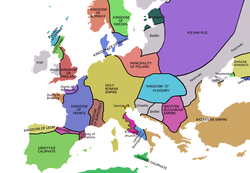Principality of Hungary
| Principality of Hungary | ||||||||||||||||||||||
| Magyar Nagyfejedelemség | ||||||||||||||||||||||
|
||||||||||||||||||||||
|
||||||||||||||||||||||
|
Europe in the late tenth century, Principality of Hungary (cyan)
|
||||||||||||||||||||||
| Capital | Esztergom and Székesfehérvár (from the reigns of Taksony and Géza) | |||||||||||||||||||||
| Religion |
Hungarian paganism Tengrism Shamanism Slavic paganism Christianity |
|||||||||||||||||||||
| Government |
Gyula-Kende sacred diarchy (early) Tribal confederation |
|||||||||||||||||||||
| Kende | Kurszán (?–c. 904) | |||||||||||||||||||||
| Grand Prince (gyula) |
Árpád (c. 895–c. 907) | |||||||||||||||||||||
| Zoltán (c. 907–c. 947) | ||||||||||||||||||||||
| Fajsz (c. 947–c. 955) | ||||||||||||||||||||||
| Taksony (c. 955–c. 972) | ||||||||||||||||||||||
| Géza (c. 972–997) | ||||||||||||||||||||||
| Stephen (997–1000) | ||||||||||||||||||||||
| Historical era | Middle ages | |||||||||||||||||||||
| • | Established | c. 895 | ||||||||||||||||||||
| • | ended at the coronation of Stephen I |
25 December 1000 or 1 January 1001 1000 |
||||||||||||||||||||
|
||||||||||||||||||||||
| Today part of |
|
|||||||||||||||||||||
The Principality of Hungary or Duchy of Hungary (Hungarian: Magyar Nagyfejedelemség: "Hungarian Grand Principality") was the earliest documented Hungarian state in the Carpathian Basin, established 895 or 896, following the 9th century Hungarian conquest of the Carpathian Basin.
The Hungarians, a semi-nomadic people forming a tribal alliance led by Árpád, arrived from Etelköz which was their earlier principality east of the Carpathians.
During the period, the power of the Hungarian Grand Prince seemed to be decreasing irrespective of the success of the Hungarian military raids across Europe. The tribal territories, ruled by Hungarian warlords (chieftains), became semi-independent polities (e.g. domains of Gyula the Younger in Transylvania). These territories got united again only under the rule of St Stephen. The semi-nomadic Hungarian population adopted settled life. The chiefdom society changed to a state society. From the second half of the 10th century, Christianity started to spread. The principality was succeeded by the Christian Kingdom of Hungary with the coronation of St Stephen I at Esztergom on Christmas Day 1000 (its alternative date is 1 January 1001).
The Hungarian historiography calls the entire period from 896 to 1000 "the age of principality".
The ethnonym of the Hungarian tribal alliance is uncertain. According to one view, following Anonymus's description, the federation was called "Hetumoger / Seven Magyars" ("VII principales persone qui Hetumoger dicuntur", "seven princely persons who are called Seven Magyars"), though the word "Magyar" possibly comes from the name of the most prominent Hungarian tribe, called Megyer. The tribal name "Megyer" became "Magyar" referring to the Hungarian people as a whole. Written sources called Magyars "Hungarians" prior to the conquest of the Carpathian Basin when they still lived on the steppes of Eastern Europe (in 837 "Ungri" mentioned by Georgius Monachus, in 862 "Ungri" by Annales Bertiniani, in 881 "Ungari" by the Annales ex Annalibus Iuvavensibus).
...
Wikipedia



